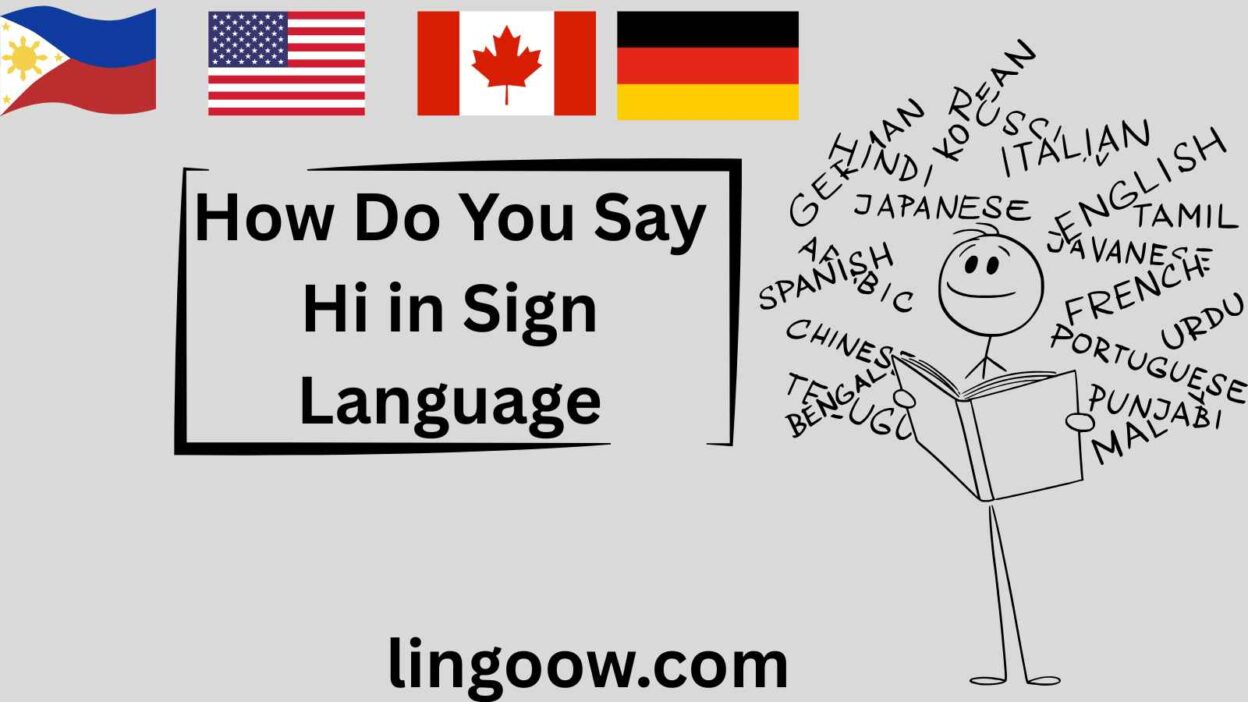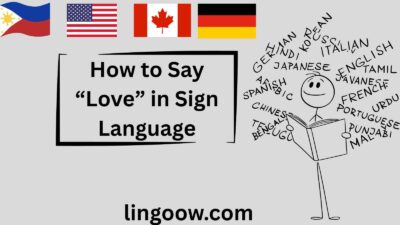Imagine this: I’m standing in a bustling airport in Tokyo, jet-lagged and clutching a crumpled boarding pass, when a little girl tugs at her mother’s sleeve.
She raises her tiny hand, palm forward, and waves with a grin that could melt glaciers. No words. Just that universal flicker of connection.
In that moment, I realized “hi” isn’t just a sound—it’s a bridge.
Across oceans, mountains, and millennia, every culture has its own way of saying hello, yet the heartbeat beneath is the same: I see you. You matter.
Today, we’re diving into the beautiful mosaic of greetings—spoken, signed, bowed, or cheek-kissed—starting with the silent poetry of sign language, then traveling the globe to uncover how humanity says “hi.”
Buckle up; your next conversation might just change the world.
Quick Reference Table: “Hi” in 15+ Languages
| Language | Word/Phrase | Cultural Insight |
| American Sign Language (ASL) | Open hand, palm out, gentle wave or salute to forehead | Rooted in Deaf community resilience; the wave is a visual “I’m here!” |
| French | Bonjour | Literally “good day”; used until dusk, reflects formality and time-awareness |
| Spanish | Hola | Warm, casual; often paired with a kiss on each cheek in Latin America |
| Italian | Ciao | Doubles as hello/goodbye; born in Venetian dialect meaning “I’m your slave” |
| German | Hallo | Direct, efficient; Guten Tag is more formal, tied to punctuality culture |
| Mandarin Chinese | Nǐ hǎo (你好) | Literally “you good”; tone matters—wrong pitch can mean “you good?” vs. “you good!” |
| Japanese | Konnichiwa (こんにちは) | “This day is”; time-specific, bows deepen with respect |
| Korean | Annyeonghaseyo (안녕하세요) | Bow + honorifics; age hierarchy shapes depth of bow |
| Hindi | Namaste (नमस्ते) | “I bow to the divine in you”; palms pressed, rooted in spirituality |
| Arabic | As-salāmu ʿalaykum (السلام عليكم) | “Peace be upon you”; response completes the circle of peace |
| Swahili | Jambo or Habari | Jambo = “affair?”; Habari = “news?”—greeting as conversation starter |
| Zulu | Sawubona | “I see you”; response Yebo affirms mutual visibility |
| Yoruba | Ẹ n lẹ́ | “How are you (pl.)?”; plural even for one person, emphasizing community |
| Māori | Kia ora | “Be well”; used in powhiri (welcome ceremonies) with hongi (nose press) |
| Hawaiian | Aloha | Breath of life; hello, goodbye, love—all in one sacred word |
European Languages: Politeness, Passion, and Punctuality
Europe is a tapestry of tongues where “hi” can be a formal affair or a fiery embrace.
- French (Bonjour): The French guard their bonjour like a secret handshake. Say it once when entering a shop; skip it, and you’ve committed a social sin. It’s not just “good day”—it’s acknowledging the day itself.
- Spanish (Hola): In Spain, it’s a quick hola; in Colombia, it’s ¡Hola, mi amor! with a hug that lasts three heartbeats. Latin American warmth turns greeting into theater.
- Italian (Ciao): Born from s-ciavo (“I’m your slave”), ciao is now the ultimate casual flex—used with friends, baristas, even dogs. Pair it with a cheek kiss (two or three, depending on region).
- German (Hallo or Guten Tag): Efficiency reigns. Hallo is your Uber driver; Guten Tag is your boss. In Bavaria, Grüß Gott (“greet God”) nods to Catholic roots.
- Bonus: Portuguese (Olá): Sung with a lilting ô, it’s like the word itself is smiling.
Asian Languages: Respect, Hierarchy, and Harmony (20+ Countries)
Asia’s greetings are a masterclass in nuance—tone, bow depth, and even who speaks first matter.
- Mandarin (Nǐ hǎo) – China: Casual among peers; add nín for elders.
- Cantonese (Néih hóu) – Hong Kong: Same characters, different melody.
- Japanese (Konnichiwa) – Bow 15° for friends, 45° for bosses.
- Korean (Annyeonghaseyo) – Deep bow for grandparents; nod for classmates.
- Hindi (Namaste) – India: Pandemic-proof—no touch, all soul.
- Bengali (Nomoshkar) – Bangladesh: Similar to namaste, with a slight head tilt.
- Tamil (Vanakkam) – Sri Lanka/India: Palms together, but spoken with a singsong lilt.
- Thai (Sawasdee) – Thailand: Wai bow + gender-specific particles (ka/ khrap).
- Vietnamese (Xin chào) – Smile mandatory; add ạ for respect.
- Indonesian (Selamat pagi) – Time-specific; pagi = morning only.
- Malay (Selamat datang) – Malaysia: “Welcome” as hello in formal settings.
- Tagalog (Kamusta) – Philippines: Spanish influence (¿Cómo estás?).
- Arabic (Marhaba) – UAE: Casual; As-salāmu ʿalaykum for religious contexts.
- Persian (Salaam) – Iran: Shortened peace greeting.
- Turkish (Merhaba) – Double cheek kiss among women.
- Hebrew (Shalom) – Israel: Peace as hello/goodbye.
- Mongolian (Sain baina uu) – “Are you well?” with a sniff-kiss for elders.
- Nepali (Namaste) – Same as Hindi, but with Himalayan humility.
- Sinhala (Ayubowan) – Sri Lanka: “May you live long.”
- Burmese (Mingalaba) – Myanmar: Smile + slight bow.
Insight: In Confucian cultures, greetings reinforce social order. In India, namaste survived COVID untouched—proof of spiritual foresight.
African Languages: Community, Rhythm, and Visibility (20+ Countries)
Africa’s greetings are call-and-response symphonies—you don’t just say hi, you affirm existence.
- Swahili (Jambo) – Kenya/Tanzania: Tourist favorite; locals prefer Habari za asubuhi (morning news?).
- Zulu (Sawubona) – South Africa: “I see you”; response Yebo sawubona = “Yes, I see you too.”
- Yoruba (Ẹ n lẹ́) – Nigeria: Plural greeting even for one person—community first.
- Amharic (Selam) – Ethiopia: Shoulder bumps for friends.
- Hausa (Sannu) – Niger/Nigeria: Drawn out sannuuuu for emphasis.
- Shona (Mhoro) – Zimbabwe: Handclap + greeting.
- Wolof (Na nga def) – Senegal: “How are you doing?”—always answered positively.
- Xhosa (Molo) – South Africa: Click consonant q in some dialects.
- Twi (Ete sɛn) – Ghana: “How is it?”—rhythmic and warm.
- Igbo (Ndewo) – Nigeria: Gender-specific responses.
- Kinyarwanda (Muraho) – Rwanda: Post-genocide emphasis on reconciliation.
- Lingala (Mbote) – DRC: Sung in Congolese rumba lyrics.
- Berber (Azul) – Morocco/Algeria: “Peace” in Tamazight.
- Afrikaans (Hallo) – Namibia: Dutch roots, African soul.
- Somali (Salaam aleikum) – Horn of Africa: Islamic peace greeting.
- Malagasy (Manao ahoana) – Madagascar: “How are you doing?”
- Luganda (Oli otya) – Uganda: Response Bulungi = “Fine.”
- Setswana (Dumela) – Botswana: Rra/ Mma for sir/madam.
- Oromo (Akkam) – Ethiopia: Casual, with a handshake.
- Fula (Jam waali) – West Africa: “Did peace spend the night?”
Insight: In Ubuntu philosophy, sawubona isn’t just greeting—it’s ontology. You exist because I see you.
Indigenous & Island Languages: Land, Ancestry, and Breath (20+ Contexts)
These greetings are living fossils—tied to land, ancestors, and the elements.
- Māori (Kia ora) – New Zealand: Used in powhiri; hongi shares breath of life.
- Hawaiian (Aloha) – Hawai’i: State law recognizes it as official greeting.
- Cherokee (Osiyo) – USA: Revitalized through language apps.
- Samoan (Talofa) – Samoa: “Love be with you.”
- Fijian (Bula) – Fiji: “Life!”—shouted with kava-induced joy.
- Inuit (Ullaakuut) – Greenland: “Good morning” with a nose rub.
- Navajo (Yá’át’ééh) – USA: “It is good.”
- Quechua (Allillanchu) – Peru: “Are you well?” in Inca lands.
- Aymara (Kamisaraki) – Bolivia: “How are you?”
- Mapudungun (Mari mari) – Chile: “Good morning/good evening.”
- Guarani (Mba’éichapa) – Paraguay: Official alongside Spanish.
- Tongan (Mālō e lelei) – Tonga: “Thank you for being well.”
- Tahitian (Ia ora na) – French Polynesia: “Live long.”
- Chamorro (Hafa adai) – Guam: Spanish + indigenous blend.
- Ainu (Irankarapte) – Japan: “How are you?”—endangered but reviving.
- Yoruba (Diaspora) – Brazil (Candomblé): Ẹ n lẹ́ in rituals.
- Aboriginal (Yaama) – Australia: Gamilaraay for “hello.”
- Sámi (Buorre beaivi) – Scandinavia: “Good day” in reindeer herder tongue.
- Kalaallisut (Aluu) – Greenland: Casual hello.
- Maasai (Supa) – Kenya/Tanzania: Jump dance may follow.
Insight: Many indigenous greetings invoke life force—breath (aloha), land (kia ora), or ancestors (osiyo).
Cultural Insights: The Evolution of “Hi”
- Etymology: English “hi” likely from Old English hī (hey), amplified in 19th-century America.
- Oldest Recorded: Sumerian cuneiform (3000 BCE) has silim (“health/peace”).
- Religious Roots: Shalom, Salaam, Namaste—all invoke divine peace.
- Colonial Impact: Hola spread via Spanish conquest; Jambo simplified Swahili for traders.
- Digital Age: Emojis (👋) and GIFs now carry the wave across borders.
Proverbs About Greetings
- Japanese: “A greeting is the first step to friendship.”
- Yoruba: “A person who doesn’t greet is carrying a corpse.”
- Italian: “Chi non saluta, non ha educazione.” (Who doesn’t greet has no manners.)
- Zulu: “Umuntu ngumuntu ngabantu.” (A person is a person through people—greetings start the chain.)
- Hawaiian: “Aloha is the essence of relationships.”
FAQs
Why do so many languages use “sa-/sha-” sounds?
Linguists link it to Proto-Indo-European swa- (health/peace). Arabic salaam, Hebrew shalom, Sanskrit svasti—all cousins.
What’s the oldest known greeting?
Sumerian silim (3100 BCE) on clay tablets: “Are you in peace?”
Conclusion: The Universal Wave
From the silent wave of ASL to the nose-press of the Māori hongi, every “hi” is a love letter to humanity. It says: In a world of 8 billion stories, I choose to start yours with kindness.
Next time you greet someone, pause. Feel the weight of centuries in that single word or gesture. Then—wave back.




